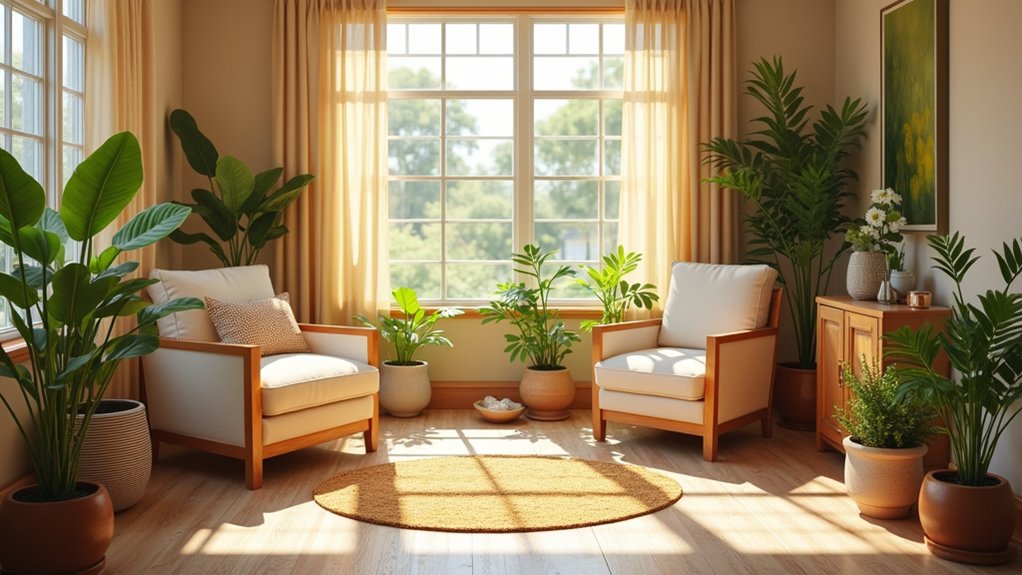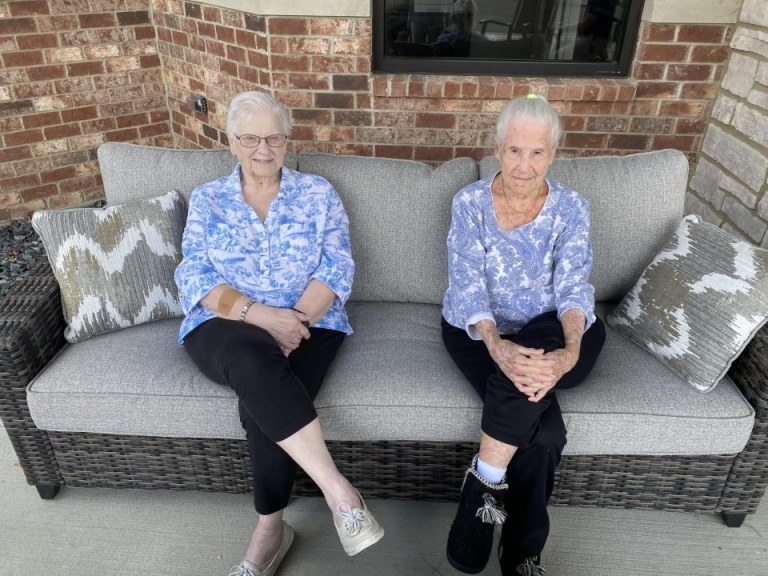When designing senior living spaces for sensory wellness, you’ll want to focus on creating comfort tailored to aging needs. Use soft textures and calming scents to soothe, while bright, glare-free lighting helps with visibility. Add soundproofing and acoustic panels to keep things tranquil. Incorporate familiar tactile elements like knitted throws for emotional connection. Balance lively communal areas with quiet nooks for relaxation. Stick around to uncover more ways to enhance these nurturing environments.
Key Takeaways
- Prioritize bright, glare-free lighting to support aging eyes and ensure safety.
- Use sound-absorbing materials like carpets to create calming acoustic environments.
- Incorporate soft, familiar textures in decor for comfort and emotional well-being.
- Balance stimulation with quiet zones for engagement and relaxation needs.
- Integrate calming scents to soothe residents and enhance daily experiences.
Understanding Sensory Needs in Senior Living
As we age, our sensory needs evolve, and it’s essential to design senior living spaces that address these changes. You can make a difference by understanding how senses like touch, sound, and smell impact well-being in places like senior living Kentland communities. Create environments with soft textures for comfort, reduce harsh noises with soundproofing, and introduce calming scents to soothe. These small changes show you care about their daily experiences.
Incorporating elements of respite care can provide necessary support and attention, enhancing the overall sensory experience for residents. You’ve got the power to transform spaces into havens of peace. Pay attention to sensory triggers that might cause stress and adapt accordingly.
Optimizing Visual Comfort Through Lighting
Let’s focus now on optimizing visual comfort through lighting in senior living spaces. As you design environments for seniors, especially in assisted senior living Kentland facilities, prioritize lighting that supports their visual needs.
Aging eyes require brighter, glare-free illumination, so install adjustable fixtures to enhance visibility and reduce strain. Use warm-toned LED lights to mimic natural daylight, fostering a soothing atmosphere.
Guarantee pathways and common areas are well-lit to prevent falls, showing your dedication to their safety. Incorporate dimmable options in personal spaces, allowing residents to customize their comfort. Additionally, consider implementing safety measures such as emergency call buttons and slip-resistant flooring to further enhance their well-being.
Creating Calming Acoustic Environments
While designing senior living spaces, prioritize creating calming acoustic environments to enhance residents’ well-being. You can make a real difference by reducing noise levels in places like an assisted living community Kentland, where peace matters.
Start by installing sound-absorbing materials such as carpets and acoustic panels to dampen echoes and harsh sounds. Encourage the use of soft furnishings to further minimize disruptive noise.
You’ll also want to take into account quiet zones where residents can relax without distraction. Pay attention to equipment and HVAC systems—opt for quieter models to keep the atmosphere serene. Additionally, incorporating community support can foster a more tranquil and connected environment for residents.
Incorporating Tactile Elements for Familiarity
Think about adding tactile elements to senior living spaces to bring a sense of familiarity and comfort. As you design environments for elderly care Kentland residents, consider incorporating textures that evoke memories, like soft quilts or rough wooden surfaces.
These materials can ground seniors, reminding them of cherished past experiences. You can make a difference by placing tactile objects—think knitted throws or smooth river stones—within easy reach.
Encourage interaction by integrating these elements into furniture or decor, fostering a nurturing space. Pay attention to safety, ensuring items aren’t too heavy or sharp. Additionally, creating a welcoming environment can significantly enhance the overall well-being of residents.
Harnessing the Power of Aromas
As you design senior living spaces, consider harnessing the power of aromas to evoke positive emotions and memories. Scents like lavender can calm anxious minds, while familiar smells like baked goods might spark cherished recollections for seniors. You’ve got the chance to create comforting environments that nurture well-being through thoughtful sensory design.
When partnering with senior care services in Kentland, integrate aromatherapy into communal areas and private rooms. Use diffusers with essential oils to maintain a subtle, pleasant atmosphere. Guarantee scents aren’t overpowering, as sensitivity varies among residents. Additionally, creating a vibrant community can enhance the overall sensory experience for residents and promote social interactions.
Designing for Safe and Intuitive Navigation
Let’s shift focus from the soothing power of aromas to creating spaces that prioritize safe and intuitive navigation for seniors. As someone dedicated to serving others, you can make a profound impact by designing environments that prevent falls and confusion.
Guarantee clear, wide pathways with non-slip flooring and install handrails for support. Use contrasting colors to highlight changes between rooms, helping seniors distinguish spaces easily.
In personalized assisted living Kentland communities, you’ll find tailored designs that enhance wayfinding with visible signage and familiar landmarks. Incorporating daily living assistance into the design can further enhance the safety and comfort of residents.
Add ample lighting to eliminate shadows and reduce risks. By focusing on these elements, you’re not just building spaces—you’re fostering independence and dignity for seniors who rely on your thoughtful care.
Balancing Stimulation and Relaxation Zones
While designing senior living spaces, prioritize creating a harmonious balance between stimulation and relaxation zones to support emotional and mental well-being.
As you craft environments for seniors, consider how communal areas can buzz with activity—think game rooms or social hubs—encouraging engagement and connection. Yet, make certain you’ve got quiet corners, like serene gardens or cozy reading nooks, where residents can unwind and recharge. This balance is essential for enhancing residents’ overall quality of life through personalized care plans that cater to their individual needs.
When serving communities like 24-hour assisted living Kentland, remember you’re shaping spaces that nurture both energy and peace.
Design with intention, placing vibrant zones near common areas for easy access, while tucking restful spots away from noise. By balancing these elements, you’ll create a supportive haven that meets diverse needs and fosters true wellness every day.
Personalizing Spaces for Emotional Well-Being
How can you make senior living spaces feel like home? You can start by personalizing environments to reflect the unique stories and preferences of seniors. Encourage them to bring cherished photos, mementos, and furniture that spark joy and comfort.
As someone dedicated to serving others, you’ll find that these small touches foster emotional well-being and a sense of belonging. Facilities like Autumn Trace Bedford prioritize individualized care plans that enhance the quality of life for residents, allowing them to create spaces that truly feel like home.
Consider facilities like affordable assisted living Kentland, where you can advocate for customizable spaces. Help seniors choose calming colors or arrange layouts that suit their needs.
Frequently Asked Questions
How Do Sensory Spaces Impact Seniors’ Mental Health?
Hey, have you ever wondered how sensory spaces impact seniors’ mental health? You can make a real difference by understanding this.
These spaces stimulate senses like touch, sight, and sound, helping reduce anxiety and lift moods.
You’ll see seniors feel more connected and engaged when you create calming environments.
Don’t underestimate your power to boost their well-being—your thoughtful efforts can brighten their days and nurture their emotional health!
What Budget Considerations Exist for Sensory Designs?
When planning sensory designs, you’ve gotta think about budget considerations first.
Don’t worry, you can make a big impact without breaking the bank. Allocate funds for essential elements like calming textures or soothing sounds that uplift spirits.
Prioritize cost-effective materials and scalable features. You’re serving others, so stretch every dollar by seeking grants or community support.
How Can Technology Enhance Sensory Wellness Spaces?
Hey, let’s explore how technology can enhance sensory wellness spaces.
You can integrate smart lighting to adjust brightness and color, creating calming vibes. Use sound systems to play soothing music or nature sounds that uplift spirits.
Don’t forget touchscreens for interactive experiences, helping others engage. Add aromatherapy diffusers with timers for consistent scents.
You’re crafting spaces that nurture well-being, making a real difference in people’s lives every day.
What Training Do Staff Need for Sensory Environments?
Hey, let’s talk about what training you need to manage sensory environments effectively.
Immerse yourself in programs that teach you how to create calming, engaging spaces with proper lighting, sound, and textures. Learn to recognize individual needs and adapt settings accordingly.
Don’t skip courses on empathy and communication—they’re key to connecting with others. Equip yourself with these skills, and you’ll make a real difference in people’s daily comfort and joy.
How Do Cultural Differences Affect Sensory Design?
Hey, let’s explore how cultural differences impact sensory design.
You’ve gotta consider that people’s backgrounds shape their sensory preferences—think smells, sounds, or colors that feel comforting or familiar.
Embrace these variations by researching and engaging with diverse communities.
Tailor your designs to honor their traditions and values.
When you prioritize cultural sensitivity, you’re creating spaces that truly resonate, making everyone feel seen, valued, and cared for.






